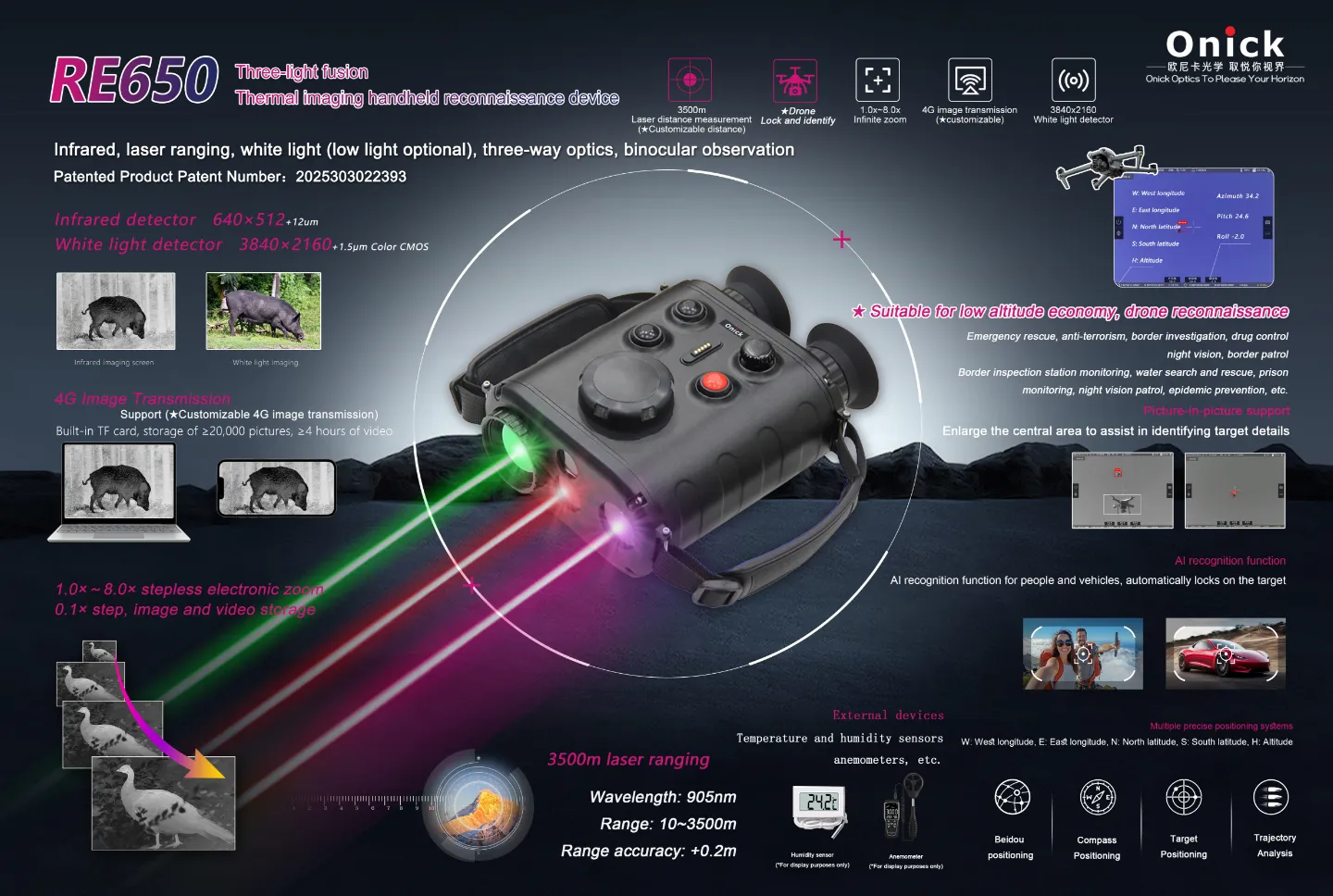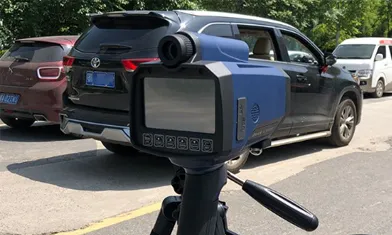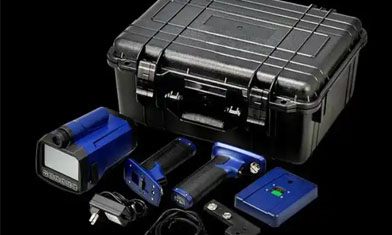Détecteur de vie à imagerie thermique infrarouge, détecte et localise les survivants dans les ruines
Le détecteur de vie d'imageur thermique portatif à trois lumières RE650 utilise les caractéristiques de température constante du corps humain pour capturer le rayonnement infrarouge grâce à un détecteur haute sensibilité, le convertissant en imagerie thermique claire, qui n'est pas affectée par la lumière et la fumée, et peut localiser rapidement les survivants dans les ruines.

Onick RE650 est un instrument d'observation et de reconnaissance d'imageur thermique portatif à trois lumières équipé d'une caméra de télévision, d'un imageur thermique infrarouge non refroidi, d'un télémètre laser, d'un GPS, d'une boussole électronique et d'autres fonctions. Il peut être utilisé pour la reconnaissance diurne et nocturne par tous temps, le positionnement de la cible, etc. Le produit a de bons effets d'imagerie infrarouge, et est petit et léger, faible consommation d'énergie, commande simple, apparence légère, léger et portable, et a une bonne prise en main. Le produit utilise un capteur infrarouge haute résolution, a de bons effets d'imagerie infrarouge, une consommation d'énergie ultra-faible, un démarrage rapide, une commande simple, une structure compacte et stable.
Principales fonctions :
1. Imagerie infrarouge, lumière blanche, observation binoculaire, stockage d'images et de vidéos ;
2. Zoom électronique 1,0 ~ 8,0 zoom continu, étape 0,1 ;
3. Télémétrie laser, positionnement Beidou, orientation de la boussole, positionnement de la cible, fonction de calcul de la trajectoire ;
4. Interface d'expansion réservée, peut être connectée au capteur d'humidité, à l'anémomètre, etc. ;
5. Avec l'altitude du brouillard, l'angle de roulis, le de pression atmosphérique, le diagnostic 1179840016. Fonction de reconnaissance IA des cibles humaines et des véhicules ; verrouiller et identifier les drones ;
Application field
Applicable à l'économie à basse altitude, au sauvetage d'urgence, à la lutte contre le terrorisme, à la reconnaissance, à la défense des frontières, au contrôle des drogues, à la vision nocturne, à la patrouille frontalière, à la surveillance des postes d'inspection aux frontières, à la recherche et au sauvetage dans l'eau, à la surveillance des prisons, à la patrouille de vision nocturne, à la prévention des épidémies, etc.

2The principe de fonctionnement du détecteur de vie à imageur thermique portatif à trois lumières RE650 est basé sur la propriété physique que tous les objets de la nature émettent des rayons infrarouges. En tant qu'organisme à sang chaud, le corps humain émet en continu des rayons infrarouges d'une longueur d'onde spécifique vers l'environnement environnant, et l'intensité de rayonnement est significativement différente de celle des objets environnementaux. L'appareil reçoit ces signaux infrarouges via un détecteur d'énergie infrarouge invisible, et après conversion électrique et traitement thermique invisible. Sur l'image, le corps humain présente une zone à haute température qui est complètement différente de l'environnement à basse température environnant en raison de la génération continue de chaleur. Les sauveteurs peuvent rapidement trouver l'emplacement des survivants en identifiant cette différence de température.
Les technologies de base de l'appareil comprennent un système optique infrarouge, un ensemble détecteur et un module de traitement d'image. Le système optique infrarouge est chargé de collecter le rayonnement infrarouge dans la zone cible pour s'assurer que les signaux faibles peuvent être focalisés efficacement ; l'ensemble détecteur convertit les signaux infrarouges en signaux électriques, et la sensibilité détermine directement la capacité de détection des sources de chaleur à longue distance ou faibles ; le module de traitement d'image effectue une réduction et une amélioration du bruit sur le signal d'origine pour rendre l'image thermique plus claire, ce qui est pratique pour les sauveteurs pour porter des jugements préciss.
Il n'est pas limité par les conditions de travail de jour ou de nuit. Il a une forte capacité de pénétration de la fumée, de la poussière et d'autres obstructions, et peut détecter les conditions internes à travers les lacunes des ruines. L'équipement est facile à utiliser et les sauveteurs peuvent scanner rapidement la zone cible en la tenant ou en l'installant, et générer des images thermiques en temps réel. Grâce à une numérisation et une analyse d'images continues, l'emplacement approximatif et le nombre de survivants peuvent être déterminés.





















